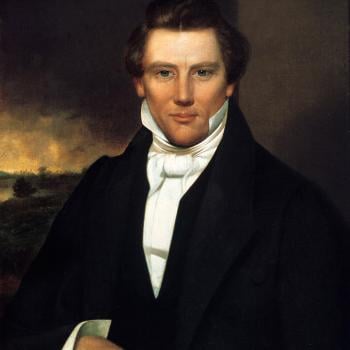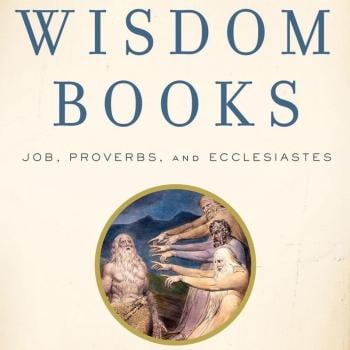 Moyer V. Hubbard, Christianity in the Greco-Roman World. A Narrative Introduction, (Baker, 2010), 344 pages, $24.99.
Moyer V. Hubbard, Christianity in the Greco-Roman World. A Narrative Introduction, (Baker, 2010), 344 pages, $24.99.
There are books which are coal mines, all you get out of them is stuff that quickly burns up— lots of heat, not much light, and too much blown smoke. And you end up with soot on your hands. Then there are books that are like tin mines— yes, they are useful, but its not the most precious metal and frankly its too fragile and malleable. And then there are books that are like gold mines— and this book by Moyer Hubbard is one of those. This is one of those books where you say “sell the dog and buy this book.” It really is that good. And for a textbook, its quite creative as well. It is called a narrative Introduction, because we have four little fictional vignettes about first century life in Paul’s Corinth, each of which are quite charming and helpful in giving a feel for the context and the times. Dr. Hubbard is a gifted writer.
What are the virtues of this book, besides the use of interesting fictional illustrations? Well first there is the use of a veritable boat load of citations from the primary Greco-Roman sources. This collection of apt quotes is alone worth using this book as a textbook for, but there are other good reasons as well. There is also copious bibliography and footnoting for each chapter, leaving one plenty of rabbit trails to chase down. It’s a great resource for further research.
Thirdly, Hubbard doesn’t merely review the Greco-Roman data that is of relevance to the study of the NT. In each of the four major sections of the book, he applies the material to specific NT examples, focusing specially on relevant material especially in Paul and Acts. One could however have wished for much more of this integration and application to the NT material in each of the four major sections.
While reading the text, you will not get bogged down in the he said she said debates between scholars in this textbook. If you want that, you can read the endnotes (which would have been more helpful had they been not relegated to the back of the book, but put at the bottom of the page— (try Kindling that sort of flipping back and forth). Fifthly, this book is well written indeed and at various points it has a just mot or two worth quoting. It includes a little glossary of terms for those unfamiliar with some technical terms, useful indexes, guides to who’s who among the Greco-Roman writers, and the like. Care has been taken in putting this book together, and in writing it.
The four major divisions of the book are topical in character and all are introduced by the aforementioned little fictional vignettes. The headings are 1)Religion and Superstition; 2) Education, Philosophy, and Oratory; 3) City and Society; and 4) Household and Family. Though there are a few hand drawings in the book, one could have wished for a lot more drawings, pictures, diagrams, charts, to get a better feel for ancient life and its appearance.
The past, as one wise man said, is indeed like a foreign country, they do things differently there, and this book demonstrates in spades my old axiom about how you can’t afford to read the Bible without studying its context because ‘a text without a context is just a pretext for whatever you want it to mean’. Let me first say that it is clear that Moyer has spent a long time in the vineyard of Greco-Roman antiquity, and time and again he reflects good judgment in his assessment of the significance and relevance of these sources. Now there are certainly things where I would differ with him, when it comes to interpretation of either these sources or the NT, but by and large his judgment is excellent and his reading of the data accurate. That’s one of the most valuable aspects of this book. It is one thing to assemble the relevant evidence, it is another to properly critically sift and assess and comment on it. All this happens in this little book (the text is only 235 pages counting the Introduction and Epilogue).
At this juncture, it will be useful to state some of the ways I think this book could be improved. There are not many mistakes or typos in this book, and I have sent the author some of them for its next edition (and I hope there will be many such editions). We will certainly use this book as a textbook at Asbury— no question. It will be good for most all levels of NT study, including as an Intro text for our doctoral students.
The weakest section in this study, and the one where I find some lapses in good judgment and reading of the evidence is Part Two on ancient education and oratory. While it may be true that literacy was only the provenance of about 10-15% of the public in these oral cultures, it is not true that only that percentage of persons were educated or were consumers or producers of good rhetoric. The graffiti evidence in Pompeii alone makes clear that all sorts of people had some level of basic literacy, not just the elite. We have all know good preachers who couldn’t write a good essay if they tried.
Moyer is in fact wrong that rhetoric was not part of elementary education. Various of the elements of the progymnasmata were already taught to children— including the ability to produce rhetorical comparisons and to form chreiae. And we need to understand as well that while only the higher status persons were likely to have all three levels of rhetorical education (there was rhetoric involved at every level of education in antiquity) nevertheless, without formal training many people picked up rhetorical skills just from listening to good orators. These were rhetoric saturated cultures, without any doubt.
A further difficulty with Part Two of this study is that while there were plenty of sophists around using rhetoric mainly as a vehicle to display their oratorical skills, by no means was all rhetoric in the first century world “full of sound and fury, signifying nothing”. The mistaken impression could be gathered from Part Two in this study that almost all rhetoric in Paul’s day was sophistry, and so Paul is claiming to avoid using rhetoric in 1-2 Corinthians. This is in fact not what Paul is claiming. Rather, he is claiming not to use mere verbal pyrotechnics without substance. That is a different matter.
The rhetoric of the assemblies and the rhetoric of the law courts was not merely exercises in sophistry, in spite of its sophistication. It was often substantive and serious business. One could also have wished for a little discussion on the difference between Asiatic rhetoric and Atticizing rhetoric, more preferred in the western end of the Empire. But these complaints do not negate the fact that even Part Two of this book is full of good information. The reader wanting to assess rhetoric in the NT itself should have a read of my little textbook entitled New Testament Rhetoric which discusses the relevance of historical rhetorical practice for the study of the NT.
There are a few other places where there are some errors in judgment in this book, for example, in Part Four, it is unlikely that Paul, a Pharisee, who had not converted to Christianity until well after he was an adult, had not been married. Indeed, his implicit identification with the widower in 1 Cor. 7 suggests Paul, if not a widower, at least could sympathize with those who found themselves single persons, after having been married. It is more likely Paul was shunned by his family once he became a follower of Christ, for he says he was a Pharisee of Pharisees, a comment about his father, not just his religious party. Paul’s affirmation of singleness has to do with spiritual gifting and he believes as a Christian he has the ‘charisma’ to remain single for Christ, and wishes others did as well. But Paul is no ascetic, as the rest of 1 Cor. 7 makes evident. He is just a man on a mission with no time for a family. John Wesley, my own forebear, would have done well to remain single as well instead of engaging in that train wreck of a marriage with Molly Vazeille.
I think also Moyer’s judgment about the social implications of Paul’s teaching about slavery can be questioned, especially when it comes to Philemon where Paul indeed implies that if someone has become a Christian they should be seen as “no longer a slave, but rather as a brother, and so more than a slave”. Paul is not just arguing for the manumission of a slave named Onesimus in that little letter. He is arguing for a paradigm shift in the way Christians view slaves who are also brothers or sisters in Christ, and what one should do about their slave status if one is Christian and a master. What we have in Philemon is not the same as what we find in Colossians (first order moral discourse— where one starts with people you don’t know) or what we find in Ephesians (a further step in moral instruction for those who have heard from you before). Rather in Philemon we have third order moral discourse— the discourse between intimates, indeed between co-workers in Christ, and here Paul pulls no punches, but displays his full heart on the subject of Christians and slavery. We need to let the radical implications of Philemon sink in, and allow them to be what they are— radical for their day.
Despite these quibbles about a decided minority of this fine book, I can only say this is one of the finest textbooks I have read in a very long time. It brought joy to my heart to give it a close reading, and to see all the good evidence and judgment applied in it, and it was a pleasure to read. After 30 years of teaching it is an especial pleasure to read a basic book like this, and still learn much from it. This book is in various ways a much better introduction to Christianity in the Greco-Roman world, than the book I reviewed in multiple posts earlier this year— Luke Johnson’s interesting book on Was Early Christianity a Greco-Roman Religion?.
In closing I would remind you of just how valuable a book like this is when it comes to relating context to Biblical content— Erasmus once said “when I get a little money I buy books. If anything is left over, I buy food.” This is one of those books worth forgoing a meal or two to purchase.














